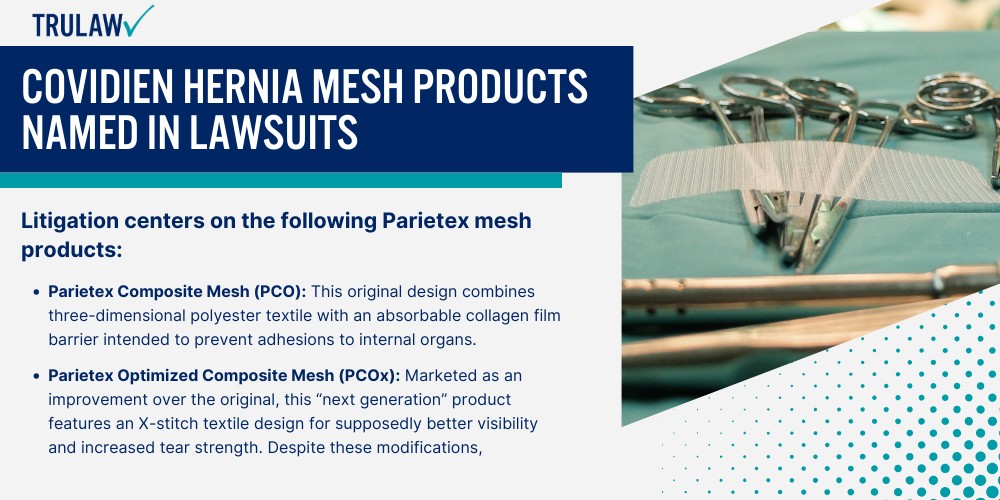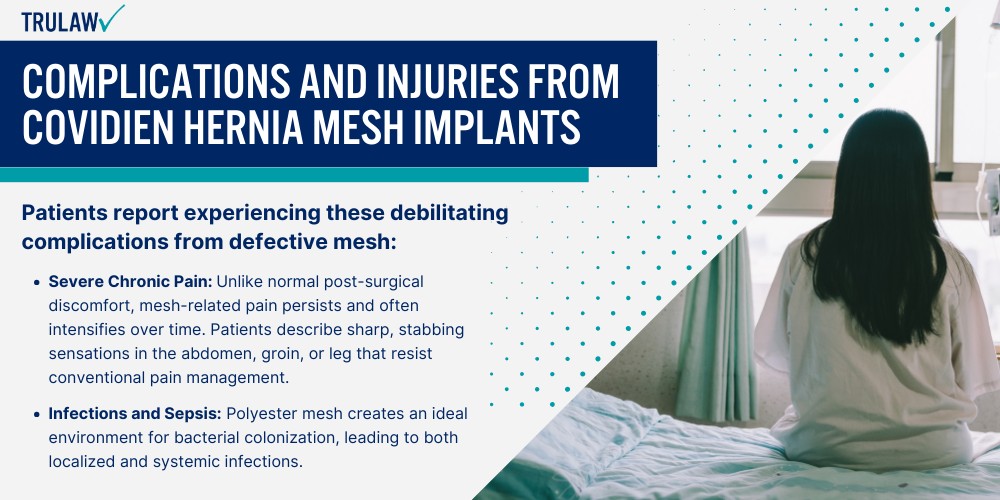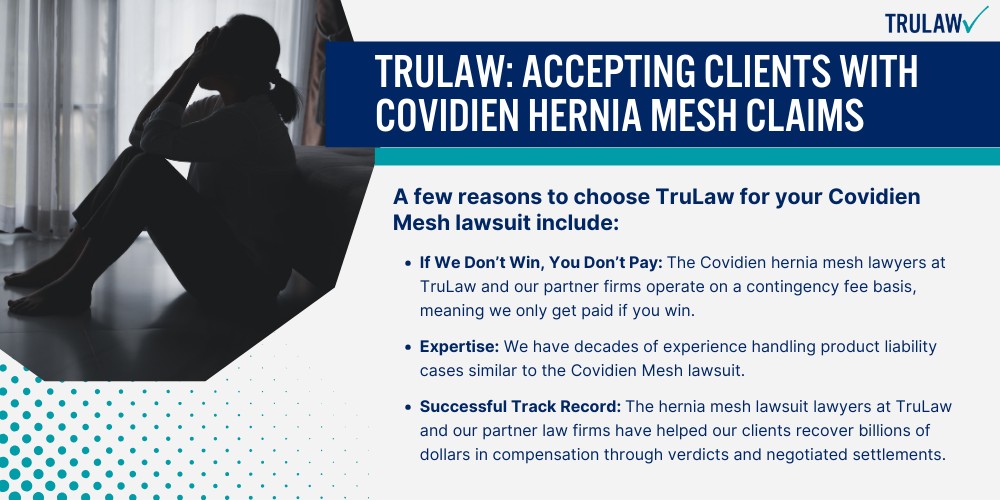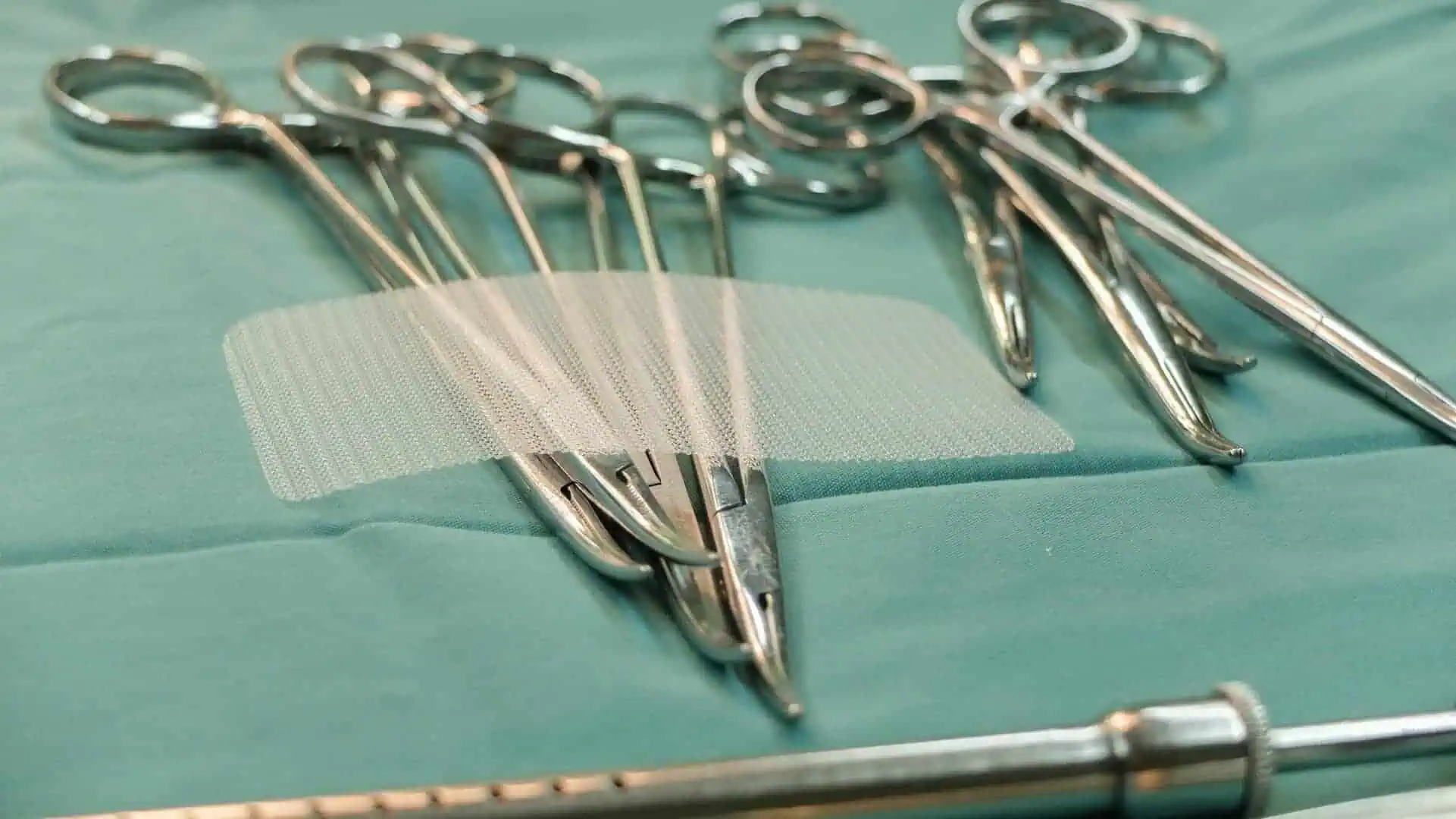The defective hernia mesh product lines at the center of thousands of Covidien hernia mesh lawsuits share a distinctive characteristic that sets them apart from competitors: their polyester construction.
Unlike industry leaders who primarily use polypropylene, Covidien chose polyester materials for many of their hernia mesh devices, receiving FDA approval through the controversial 510(k) fast-track process.

This regulatory pathway allowed Covidien to market products without human clinical trials by claiming “substantial equivalence” to existing devices, meaning serious design flaws only emerged after thousands of patients received implants through hernia mesh surgery.
Parietex Product Line and Associated Complications
The Parietex product family represents Covidien’s flagship hernia mesh line, first introduced with Parietex Composite Mesh receiving FDA 510(k) clearance in 1999.
Scientific evidence supporting these concerns dates back decades.
A 1998 study published in the Journal of the American Medical Association Surgery specifically warned against using polyester in synthetic mesh, concluding that multifilament polyester showed “incredibly high infection rates.”
Despite this warning, Covidien continued developing polyester-based mesh products alongside other hernia mesh companies.
The shift to monofilament polyester designs addressed some infection concerns but introduced new problems with tearing and mechanical failure, leading to pending hernia mesh lawsuits.
Litigation centers on the following Parietex mesh products:
- Parietex Composite Mesh (PCO): This original design combines three-dimensional polyester textile with an absorbable collagen film barrier intended to prevent adhesions to internal organs. However, medical experts have discovered the collagen coating often absorbs prematurely within 30 days, defeating its protective purpose and leaving organs exposed to direct mesh contact. The polyester base exhibits shrinkage rates of 30-50%, potentially causing the mesh to pull away from attachment points and create gaps where hernias can recur.
- Parietex Optimized Composite Mesh (PCOx): Marketed as an improvement over the original, this “next generation” product features an X-stitch textile design for supposedly better visibility and increased tear strength. Despite these modifications, the fundamental polyester construction problems persist. The optimized version still uses the same problematic collagen barrier that absorbs too quickly, and the large pore design intended to reduce infection risk may actually allow bacteria to penetrate more easily.
- Parietex ProGrip Self-Fixating Mesh: This innovative design incorporates thousands of micro-grips designed to eliminate the need for surgical tacks or sutures during inguinal hernia repair procedures. While marketed as reducing post-operative pain, these micro-grips can cause excessive scarring and make revision surgery extremely difficult. Surgeons report that the self-fixating mechanism creates such strong tissue adherence that safe removal becomes nearly impossible, leaving patients with permanent complications.
- Parietex Plug and Patch System: Designed specifically for ventral hernia repair and inguinal hernia repair (can be used for both left inguinal hernia repair and right inguinal hernia repair) – this two-component system requires precise placement on the first attempt. The plug component, when folded into its cone shape, has been reported to migrate from its intended position. The patch component suffers from the same polyester degradation issues as other Parietex products, with unsealed edges that allow fibers to unravel within the body.
According to FDA adverse event reports, Parietex products have generated numerous complications requiring surgical intervention.
One 2017 report documented a patient requiring panniculectomy because fat necrosis had grown onto the Parietex Composite mesh.
Another report described mesh with “a small hole, about a centimeter in diameter, in the center” discovered during revision surgery, demonstrating the material’s tendency to degrade compared to biologic mesh alternatives.
ProGrip, Symbotex, and Other Covidien Mesh Devices
Beyond the Parietex line, Covidien manufactures several other hernia mesh products now subject to litigation across active hernia mesh MDLs.
Covidien’s recall history reveals a pattern of limited, targeted actions rather than comprehensive safety measures.
In October 2018, the company recalled 7,333 units of Parietex Composite Parastomal Mesh after reports of mesh failure using the modified Sugarbaker repair technique.
The FDA classified this as a Class 2 recall, indicating products that “may cause temporary or medically reversible adverse health consequences.”
A second recall occurred in January 2021, affecting 129 units of Parietex Hydrophilic Anatomical Mesh due to packaging errors where left-side labels contained right-side products, prompting new hernia mesh lawsuits.
Beyond Parietex, several other Covidien products face legal challenges:
- ProGrip Laparoscopic Self-Fixating Mesh: While sharing the micro-grip technology with Parietex ProGrip, this laparoscopic version presents unique challenges similar to issues in the Bard hernia mesh MDL. The gripping mechanism, designed for minimally invasive procedures, can cause excessive tissue trauma when activated. Surgeons report difficulty controlling the deployment, sometimes resulting in mesh attaching to unintended tissues. The polyester construction exhibits the same degradation patterns seen in other Covidien products.
- Symbotex Composite Mesh: Featured prominently in the upcoming February 2026 bellwether trial, Symbotex represents Covidien’s attempt to address known polyester issues. Despite modifications, plaintiffs allege the collagen coating still resorbs prematurely, exposing organs to direct mesh contact. The Alabama plaintiff in the first bellwether case required small bowel resection after Symbotex complications, highlighting the severity of potential injuries seen in hernia mesh multidistrict litigation.
- Parietex Lightweight Monofilament Mesh: Marketed as addressing weight concerns of traditional mesh, this “lightweight” designation proves misleading compared to products in the Atrium hernia mesh MDL. The monofilament polyester construction, while reducing some infection risks associated with multifilament designs, creates new problems with mechanical strength. Reports indicate this mesh tears more easily during handling and after implantation, potentially requiring complete removal and replacement.
- Dextile Anatomical Mesh: Used primarily in laparoscopic procedures, this product line shares the polyester construction defects of other Covidien meshes unlike Bard’s polypropylene hernia mesh. The anatomical shaping, intended to conform to body contours, can actually increase stress points where tearing occurs.
If you or a loved one suffered severe complications from any Covidien mesh product, including infection, chronic pain, or required revision surgery, you may be eligible to seek compensation.
Contact TruLaw using the chat on this page to receive an instant case evaluation and determine whether you qualify to join others in filing a Transvaginal mesh lawsuit today.
While seemingly minor, such mislabeling can have serious surgical implications.
Plaintiffs’ attorneys argue these limited recalls demonstrate Covidien’s reluctance to acknowledge broader design defects affecting their entire polyester mesh line.
Unlike competitors who have withdrawn entire product lines through hernia mesh class action settlements, most Covidien mesh products remain available despite mounting evidence of complications.
The absence of comprehensive recalls doesn’t indicate safety—rather, it highlights the regulatory environment where hernia mesh manufacturers can continue selling products even as thousands of patients report serious injuries.
The ongoing litigation seeks to accomplish what limited regulatory action has not: holding Covidien accountable for the full scope of injuries caused by their polyester mesh designs through hernia mesh lawsuit settlement proceedings.







